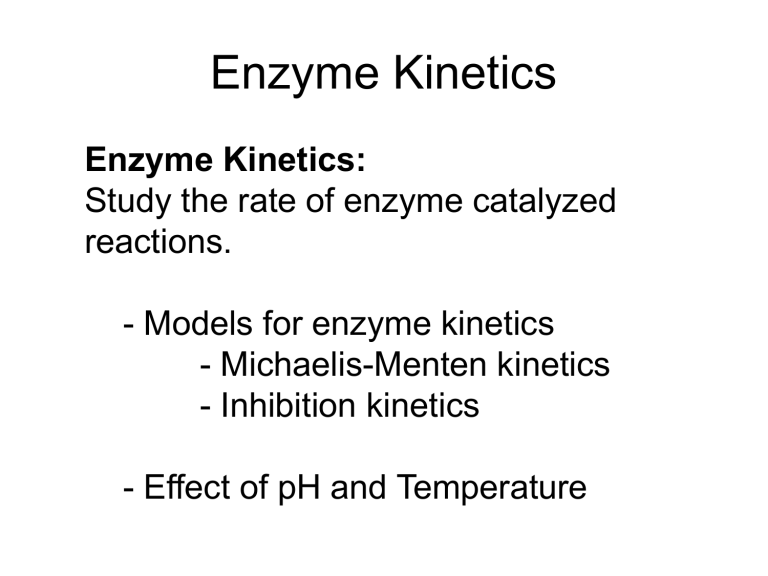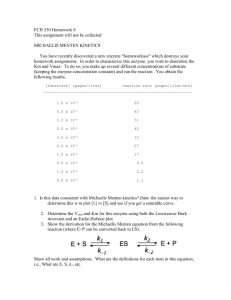Enzyme kinetics

Enzyme Kinetics
Enzyme Kinetics:
Study the rate of enzyme catalyzed reactions.
- Models for enzyme kinetics
- Michaelis-Menten kinetics
- Inhibition kinetics
- Effect of pH and Temperature
Enzyme Kinetics
Michaelis-Menten kinetics or saturation kinetics which was first developed by V.C.R. Henri in 1902 and developed by L. Michaelis and M.L. Menten in 1913.
This model is based on data from batch reactors with constant liquid volume.
- Initial substrate, [S
0
] and enzyme [E
0
] concentrations are known.
- An enzyme solution has a fixed number of active sites to which substrate can bind.
- At high substrate concentrations, all these sites may be occupied by substrates or the enzyme is saturated.
Saturation Enzyme Kinetics
M-M Enzyme Kinetics
Saturation kinetics can be obtained from a simple reaction scheme that involves a reversible step for enzyme-substrate complex formation and a dissociation step of the ES complex.
E+S
K1
K-1
ES
k
P
E where the rate of product formation v (moles/l-s, g/l-min) is v
d [ P ] dt
k
2
[ ES ]
K i is the respective reaction rate constant.
Enzyme Kinetics
The rate of variation of ES complex is d [ ES ]
k
1
[ E ][ S ]
k
1
[ ES ]
k
2
[ ES ] dt
Since the enzyme is not consumed, the conservation equation on the enzyme yields
[ E ]
[ E
0
]
[ ES ]
Enzyme Kinetics v
d [ P ] dt
k
2
[ ES ]
[ E ]
[ E
0
]
[ ES ] d [ ES ]
k
1
[ E ][ S ]
k
1
[ ES ]
k
2
[ ES ] dt
How to use independent variable [S] to represent v?
Enzyme Kinetics
At this point, an assumption is required to achieve an analytical solution.
- The rapid equilibrium assumption
Michaelis - Menten Approach.
- The quasi-steady-state assumption.
Briggs and Haldane Approach.
Michaelis - Menten Approach
The rapid equilibrium assumption:
- Assumes a rapid equilibrium between the enzyme and substrate to form an [ES] complex.
E+S
K1
K-1
ES
k
P
E k
1
[ E ][ S ]
k
1
[ ES ]
Michaelis - Menten Approach the following equation in a dilute system.
E+S
K1
K-1
ES
k
P
E
K
' m
k
1 k
1
[ E ][ S ]
[ ES ]
Michaelis - Menten Approach
Then rearrange the above equation,
[ ES ]
[ E ][ S ]
K
' m
Substituting [E] in the above equation with enzyme mass conservation equation
[ E ]
[ E
0
]
[ ES ] yields,
[ ES ]
([ E
0
]
[ ES ])[ S ]
K
' m
Michaelis - Menten Approach
[ES] can be expressed in terms of [S],
[ ES ]
[ E
0
][ S ]
K
' m
[ S ]
Then the rate of production formation v can be expressed in terms of [S], v
d [ P ] dt
k
2
[ ES ]
k
2
[ E
0
][ S ]
K
' m
[ S ]
V m
[ S ]
K
' m
[ S ]
Where V m
k
2
[ E
0
] represents the maximum forward rate of reaction ( e.g.moles/L-min ).
Michaelis - Menten Approach
K
' m is often called the Michaelis-Menten constant, mol/L, mg/L.
- The prime reminds us that it was derived by assuming rapid equilibrium in the step of enzyme-substrate complex formation.
- Low value indicates affinity of enzyme to the substrate.
-
K
' m
k
1 k
1
It corresponds to the substrate concentration, giving the reaction velocity.
v
1
2
V m
V m
[ S ]
K
' m
[ S ]
Re-arrange the above equation,
K
' m
[ S ] When v
1
2
V m
Michaelis - Menten Approach
• Vm is maximum forward velocity (e.g.mol/L-s)
• It
V m
k
2
[ E
0
] with initial enzyme concentration.
• It is determined by the rate constant k
2 of the product formation and the initial enzyme concentration.
• But it is concentration.
by the substrate
• The unit of k
2 is determined by the unit of enzyme.
Briggs-Haldane Approach
The quasi-steady-state assumption:
- A system (batch reactor) is used in which the initial substrate concentration [S
0
] greatly exceeds the initial enzyme concentration [E
0
]. since [E
0
] was small, d[ES]/dt ≈ 0
- It is shown that in a closed system the quasisteady-state hypothesis is valid after a brief transient if [S0]>> [E0].
The quasi-steady-state hypothesis is valid after a brief transient in a batch system if [S0]>> [E0].
Briggs-Haldane Approach
With such assumption, the equation representing the accumulation of [ES] becomes d [ ES ]
k
1
[ E ][ S ]
k
1
[ ES ]
k
2
[ ES ]
0 dt
Solving this algebraic equation yields
[ ES ]
k
1
[ E k
1
][ S k
2
]
Briggs-Haldane Approach
Substituting the enzyme mass conservation equation
[ E ]
[ E
0
]
[ ES ] in the above equation yields
[ ES ]
k
1
([ E
0
]
[ ES ])[ S ] k
1
k
2
Using [S] to represent [ES] yields
[ ES ]
k
1
[ E
0
k
][
2
S ]
k
1
[ S ]
Briggs-Haldane Approach
Then the product formation rate becomes v
d [ P ] dt
k
2
[ ES ]
k k
1
2
[
E k
0
2
][ S
k
1
]
[ S ]
Then, v
K
V m
[ S m
[
]
S ]
K
Where m
k
V m
k
2
[ E
0
]
1 k
1 k
2 same as that for rapid equilibrium assumption.
when K
2
<< k -1,
K m
K m
'
k
1 k
1
Comparison of the Two Approaches
Assumption:
Michaelis-Menten k
1
[ E ][ S ]
k
1
[ ES ]
Equation:
Maximum forward reaction rate: v
V m
[ S ]
K
' m
[ S ]
V m
k
2
[ E
0
]
Constant:
K
' m
k
1 k
1 when k
2
<< k-1,
Briggs-Haldane d[ES]/dt ≈ 0 v
K
V m
[ S m
[
]
S ]
K m
V m
k
2
[ E
0
]
K m
K m
'
k
1
k
1
k
1 k
2 k
2 k
1
Experimentally Determining Rate
Parameters for
Michaelis-Menten Type Kinetics.
v
K
V m m
[
S ]
[ S ]
To determine the rate parameters:
- Predict a specific enzyme catalysis system.
- Design bioreactor
The determination of Vm and Km are typically obtained from initial-rate experiments.
-A batch reactor is charged with known initial concentration of substrate [So] and enzyme [Eo] at specific conditions such as T, pH, and Ionic Strength.
- The product or substrate concentration is plotted against time.
- The initial slope of this curve is estimated. v=(d[P]/dt) , or = - (d[S]/dt) .
This value v depends on the values of [E0] and [S0].
- Many such experiments can be used to generate many pairs of V and [S] data, these data can be plotted as v-
[S].
Lineweaver-Burk Plot (Double-Reciprocal Plot) v
K
V m
[ S m
[
]
S ]
Linearizing it in double-reciprocal form:
1 v
1
V m
K m
V m
1
S
- Lineweaver-Burk plot (Double-reciprocal plot).
- a slope equals to Km/Vm
- y-intercept is 1/Vm.
- More often used as it shows the independent variable [S] and dependent variable v.
-1/v approaches infinity as [S] decreases
- gives undue weight to inaccurate measurement made at low concentration
- give insufficient weight to more accurate measurements at high concentration.
Eadie-Hofstee Plot v
V m
K m v
[ S ]
- the slope is –Km
- y-axis intercept is Vm.
-Can be subject to large error since both coordinates contain dependent variable v, but there is less bias on points at low [s].
Hanes-Woolf (Langmuir) Plot
[ S ]
v
K m
V m
1
V m
[ S ]
- the slope is –1/Vm
- y-axis intercept is Km/Vm
- better fit: even weighting of the data
Vm
V m
k
2
[ E
0
]
-The unit of Vm is the same as that of a reaction rate
(moles/l-min, g/l-s)
-The dimension of K
2 must reflect the units of [E
0
]
-if the enzyme is highly purified, it may be possible to express [E
0
] in mol/l, g/l, then K
2 in 1/time.
- if the enzyme is crude, its concentration is in units.
A “unit” is the amount of enzyme that gives a predetermined amount of catalytic activity under specific conditions.
(Textbook, Bioprocessing Engineering, M. Shuler, p.66-67)
If Vm is mmol/ml-min, [E0] is units/ml, then K2 should be in mmol/unit-min.
Enzyme Activity
Specific Activity is the number of units of activity per amount of total protein.
Ex. A crude cell lysate might have a specific activity of
0.2 units/mg or ml protein upon which purification may increase to 10 units/mg or ml protein.
One unit would be formation of one μmol product per minute at a specific pH and temperature with a substrate concentration much greater than the value of Km.
Summary of Simple Saturation
Kinetics
• Michaelis-Menten Approach
• Briggs-Haldane Approach
• Use experimental data to obtain parameters of Michaelis-Menten kinetics.



